We’ve heard it many times: Store your beer in a dark, cool place.
Light and excessive heat can damage the flavor and stability of your finished beer. They cause a variety of off-flavors and will also prematurely age your beer.
Light
We’ll begin with light since it is the simplest to address. Direct sunlight creates a specific off-flavor known appropriately as “skunky beer.” The skunky flavor and smell come from a compound known as 3-methylbut-2-ene-1-thiol, or MBT for short. This MBT “skunky” odor has a very low flavor detection threshold—as low as a few parts per trillion. All modern beers contain hops with alpha acids that become isomerized during the boil and provide bitterness to the beer. If you expose these alpha acids to UV-B light from the sun, they will combine with sulfur in the beer from the malt and give a lovely MBT compound and aroma. In direct summer sunlight, the reaction can happen in just a few minutes! To counteract skunky beer, many commercial brewers use dark-colored bottles to reduce exposure to UV light or cans to eliminate it. While a few beers “embrace the skunk” as part of their flavor complexity, most beer drinkers find it unappealing.
Heat
And now for the subject of excessive heat (well above room temperature). Beer itself is made of thousands of flavoring compounds, all of which change character over time due to slow chemical reactions that occur as the beer ages. Applying heat to your finished beer has the net effect of accelerating many of those chemical processes. Breweries perform accelerated aging tests on their beer by heating them to a high temperature (say 140°F/60°C) for a few days. So, the short answer is that heating your beer will result in premature aging. That being said, I don’t recommend heating your barley wine or old ale to 140°F/60°C to accelerate the aging, as the effects are not identical to properly aging your beer. A rule of thumb often quoted is that an 18°F (10°C) rise in temperature doubles the rate of aging.
As far as specific effects from heating your beer go, you will tend to lose hops flavor quickly, which will emphasize the deeper, rounder, caramel, malty side of the beer. This is usually the most notable difference in a beer aged hot if you were to taste it side by side with a cold-stored one. However, with enough heat and time, the malt will also lose its edge and become quite bland and dull.




































